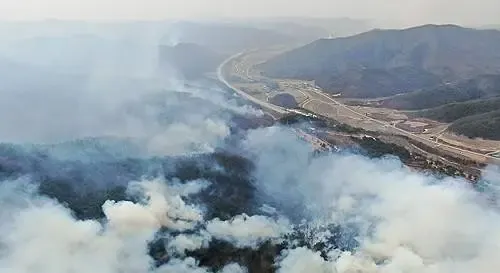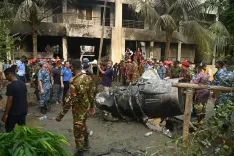South Korea: Uiseong Wildfires Escalate Out of Control

Synopsis
Key Takeaways
- Wildfires in Uiseong are worsening due to adverse weather.
- The affected forest area has expanded significantly.
- Firefighters are facing exhaustion and health issues.
- Emergency resources are being mobilized to combat the flames.
- Local authorities are implementing safety measures.
Seoul, March 25 (NationPress) The wildfires in Uiseong, located in the southeastern part of South Korea, are increasingly spiraling out of control due to unpredictable strong winds and exceedingly dry conditions, as reported by government officials on Tuesday. They highlighted a gradual decline in the area's fire extinguishing rate.
The wildfire-affected forest area in Uiseong, around 180 kilometers southeast of Seoul, expanded by more than 4,000 hectares overnight, totaling 12,699 ha as of early Tuesday morning, despite extensive firefighting efforts by local authorities.
As per the Korea Forest Service, the fire extinguishing rate in Uiseong has decreased over the last 24 hours, plummeting from 60 percent on Monday evening to 54 percent by 9 a.m. Tuesday.
The combination of unpredictable strong winds and very dry weather is significantly obstructing firefighting operations, according to officials.
As the forest fire continues to rage, the exhaustion among firefighters is becoming apparent. A firefighter from the Sangju Fire Station was hospitalized Monday afternoon after experiencing dizziness and vomiting during firefighting efforts in Uiseong, according to a report from Yonhap news agency.
Authorities are preparing to deploy 77 helicopters and 3,154 personnel to control the wildfires in Uiseong, especially as the flames have reached the nearby city of Andong.
In the past few days, the wildfires in southeastern South Korea have devastated 14,694 ha of forest, resulted in 15 injuries—including four fatalities—and displaced over 3,300 individuals, as stated by the government on Tuesday.
Acting Interior Minister Ko Ki-dong provided the latest information regarding forest fire damage at a meeting of the Central Disaster and Safety Countermeasure Headquarters in Seoul, noting that firefighting efforts are hindered by strong winds, dry conditions, and other adverse weather factors.
The government intends to mobilize all available resources on Tuesday, including 110 helicopters and 6,700 personnel, to combat the wildfires in Sancheong, Hadong, and Gimhae in South Gyeongsang Province, as well as in Uiseong of North Gyeongsang Province and Ulsan's Ulju district, Ko announced.
As of 7 a.m. Tuesday, firefighters had managed to contain an average of 88 percent of the wildfires across the five regions, according to the minister. Additional efforts will also focus on preventing the fire from encroaching on residential zones.
Local governments have enacted various safety protocols, such as roadblocks and pre-evacuation of residents, to reduce fire-related damage.
Ko also mentioned that there have been a total of 234 forest fires across the nation this year, primarily triggered by accidental fires from mountain visitors and the burning of agricultural waste or trash.








